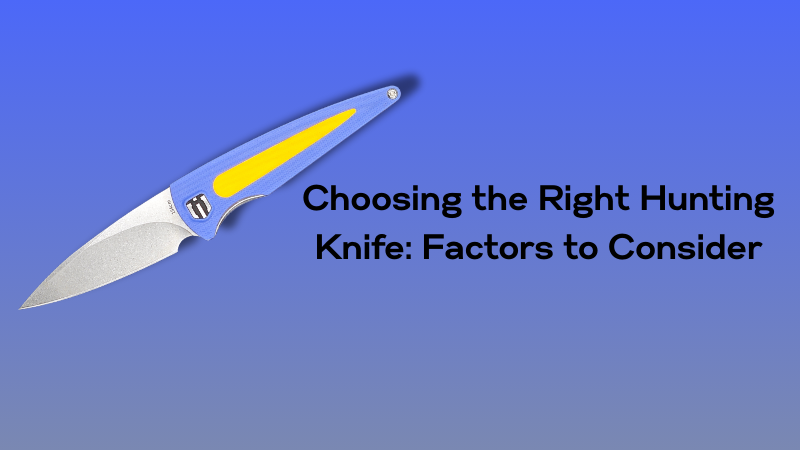
Choosing the Right Hunting Knife: Key Factors to Consider

Hunting is a thrilling and timeless pursuit enjoyed by many across regions rich in wildlife. While regulations exist to manage hunting activities, certain animals like deer are abundant enough that controlled hunting is encouraged. Yet, no matter how simple hunting seems in theory, it’s a challenging activity that demands skill, preparation, and the right equipment — especially a reliable hunting knife.
Choosing the right hunting knife is
critical. To help you make an informed choice, we’ll explore the different
types of hunting knives available and the key features you should focus on when
selecting yours.
Types of Hunting Knives

Before diving into selection criteria, it’s
important to understand the different types of hunting knives you might
encounter:
Camp Knife
The camp knife is an all-around tool, ideal
for cutting rope, making kindling, preparing meals, and even dressing game.
Designed for versatility, it typically features a robust blade that can fold
back into the handle, much like a Pocket knife. Compact and easy to carry, this
style is a staple in many hunters' gear.
Bowie Knife
A historical classic, the bowie knife
features a double-edged tip and a strong, large blade. While once widely used
for survival and defense, it’s now more commonly carried for hunting small
game. Its intimidating presence can also serve as a self-defense tool if
necessary.
Boning Knife
A boning knife, with its narrow,
lightweight design, excels at separating meat from bone. Compact enough to
function as a Pocket knife or even a specialized EDC knife in the field, it
offers great control and precision for delicate work.
Caping Knife
For hunters interested in trophy
preparation, a caping knife is indispensable. Its thin, upturned blade allows
for careful cuts without damaging the hide. Choosing a caping knife with a
longer handle enhances control for these detailed tasks.
Buck Knife
Based on the iconic design from the 1960s,
the buck knife is suited for tackling larger game. As a fixed blade tool, it’s
bulkier and requires a sheath, but it delivers unmatched cutting power —
perfect for hunters needing heavy-duty performance.
Skinning Knife
As the name suggests, the skinning knife is
designed for removing animal hides cleanly and efficiently. With a short, sharp
blade and textured handle, it allows hunters to maintain a steady grip during
intricate skinning tasks.
Factors to Consider When Choosing a Hunting Knife
 Given the wide variety of knives available,
selecting the right hunting knife can be overwhelming. Here are the essential
factors you should keep in mind:
Given the wide variety of knives available,
selecting the right hunting knife can be overwhelming. Here are the essential
factors you should keep in mind:
Fixed Blade vs. Folding Knife
Choosing between a fixed blade and a Folding Knife comes down
to usage and personal preference. Fixed blades are stronger and better for
heavy-duty tasks, but they require a sheath for safe carrying. Folding knives,
like many Shieldon knives, offer compactness and easy storage, making them a
popular choice for casual and hobbyist hunters.
Experienced hunters often prefer fixed
blades for their durability, while EDC knife fans may opt for folding designs
for lighter tasks and convenience.
Blade Shape
The blade shape influences the knife’s
functionality. The three most common hunting blade shapes are:
- Drop Point: A convex curve ideal
for skinning and field dressing.
- Straight Edge: Traditional,
versatile, and strong enough for tough cutting and piercing tasks.
- Trailing Point (Concave): Perfect
for fast, precise skinning without damaging the meat.
Select the blade shape that matches your
intended use in the field.
Handle Design and Material

A solid grip is crucial for safety and
efficiency. A good handle prevents slippage even when your hands are wet or
bloody. Look for handles with textured surfaces, ergonomic design, and grooves
to improve grip and control. Shieldon knife designs, for instance, emphasize
secure handling, ensuring comfort during prolonged use.
Portability
Portability matters, especially when moving
through rugged terrain. Pocket knives and Folding Knives offer excellent
portability, easily fitting into a jacket or pants pocket. Fixed blade knives
require a belt sheath or holster but provide added strength for demanding
tasks.
Assess whether you prioritize easy carrying
or enhanced durability when choosing between these two types.
Blade Sharpness and Edge Retention

Not all blades maintain sharpness equally.
High-carbon steel blades, common in premium Shieldon knives, offer superior
edge retention compared to standard stainless steel. Some hunting knives even
feature replaceable blades, which can be swapped out once worn down. Always
prioritize blades that hold an edge well, reducing maintenance needs during
long expeditions.
Price vs. Value
While hunting knives can be costly,
especially those made from premium materials like carbon steel, investing in
quality is worthwhile. A well-crafted knife provides reliable performance for
years, whether it's a heavy-duty fixed blade or a lightweight EDC knife.
Still, budget-friendly options exist. Keep
an eye out for reputable deals on third-party sites where high-quality knives
can be found at reasonable prices.

Conclusion
Selecting the right hunting knife takes
careful thought. Whether you’re preparing for your first hunting trip or adding
to your collection, consider factors like blade type, material, size, and
intended use. A versatile Shieldon knife,
whether a folding EDC knife, a robust fixed blade, or even a precision Martial
Arts knife adapted for field use, ensures you’re always prepared.
At Shieldon, we bring generations of
knife-making expertise to each product, offering top-tier knives crafted with
precision, durability, and performance in mind. Browse our latest hunting knife
collection today — we’ll help you gear up for your next outdoor adventure.
